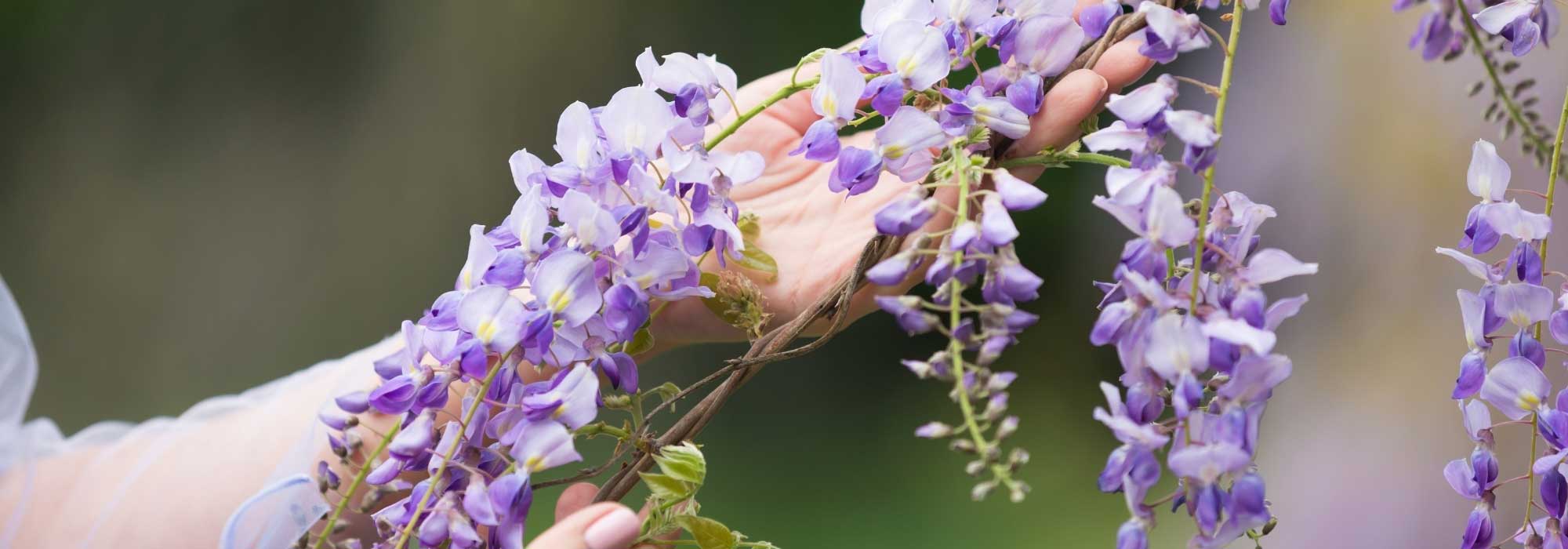
The 6 most beautiful Wisterias
A selection of stunning wisterias to adopt in the garden
Contents
Spectacular and fragrant, wisterias are a must-have in the garden. Their generous clusters of flowers, available in blue, mauve, pink, or white, provide a unique spectacle in spring. Wisteria sinensis, the famous Chinese wisteria, and Wisteria floribunda, the Japanese wisteria, are among the most commonly grown. Their cascading flowering enhances pergolas, facades, and arbours.
Want to adopt one of these exuberant lianas? Discover 6 essential varieties, easy to grow in the ground or even in pots!
→ Where and how to plant your Wisteria? Feel free to consult our guide: “Wisteria: how to plant, prune, and care?“.
Japanese Wisteria 'Honbeni': Dressed in pink
For a softly enchanting atmosphere, plant the wonderful Japanese Wisteria Wisteria floribunda ‘Honbeni’! Exuberant, it extends its branches to reach over 8 m. Voluble, it quickly wraps around any support you choose, always in a clockwise direction: along your façade, on an arch, or over a pergola. In May, its long clusters bloom one after another, and the plant is adorned with very elegant powdery pink flowers. These flowers are gently scented, and the young foliage is bronze green, turning to soft green later. This light foliage is very dense, allowing it to easily shade the spaces above which your wisteria will be guided.
The Japanese wisteria is a particularly accommodating plant: it will thrive in any sufficiently deep and not overly calcareous soil, and it even prefers poor soils. Once established, it will be able to withstand summer drought, even in the south. And if you plant it further north, it will easily endure the harshest winter cold.

Wisteria floribunda ‘Honbeni’
Read also
Wisteria: how to train and prune it?Wisteria 'Grande Diva Cecilia': a cascade of purple pom-poms
For lovers of colour and originality, Wisteria venusta ‘Grande Diva Cecilia’ will stand out. More suited to small spaces, it grows to about 5 m and self-twines around supports like all voluble climbing plants. A hybrid of the wisteria Wisteria venusta (or now Wisteria brachybotrys), it will bloom in May-June from the first years of planting, covering itself with flowers uniformly across the plant. These double flowers are grouped in fragrant and melliferous clusters about twenty centimetres long, featuring a beautiful contrasting shade of lavender blue and pale mauve. The deciduous foliage is initially a light caramel colour, then turns to soft green, brightening the support on which this beautiful climber will be displayed throughout the season.
As for growing conditions: nothing could be easier. The wisteria ‘Grande Diva Cecilia’ thrives in all conditions, although it does prefer loose soils. It copes well with summer drought and cold down to -20°C. Its more modest stature makes it an excellent choice for growing in large containers or pots. Finally, its exceptional longevity allows you to plant it for generations to come!
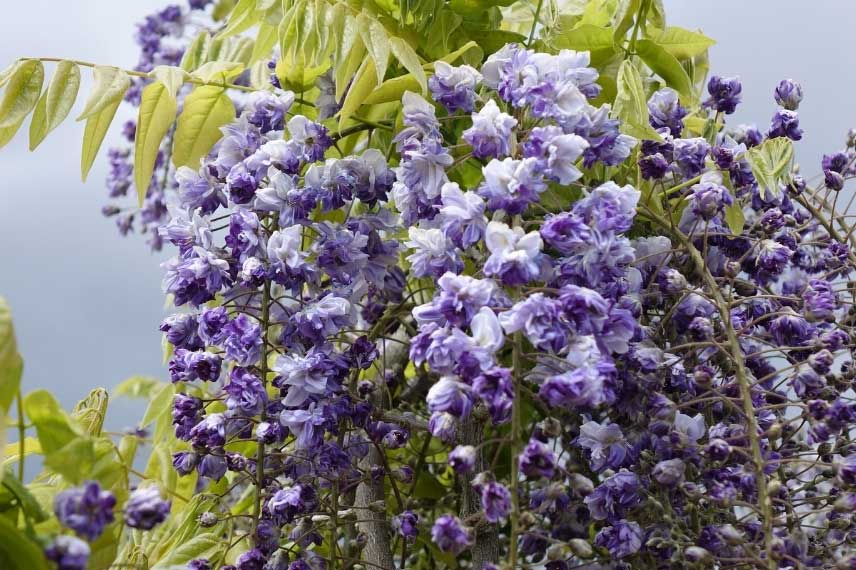
Wisteria (x) venusta ‘Grande Diva Cecilia’
Discover other Wisterias
View all →Available in 0 sizes
Available in 0 sizes
Available in 0 sizes
Available in 0 sizes
Available in 2 sizes
Available in 1 sizes
Available in 0 sizes
Available in 1 sizes
Available in 3 sizes
Available in 1 sizes
Wisteria 'Grande Diva Nathalie': bicolour
This wisteria is another cultivar from the ‘Grande Diva’ series. Showcasing the same qualities as the previous one, the Wisteria venusta ‘Grande Diva Nathalie’ bursts into an incredible bicolour flowering of violet and light mauve in May-June. The clusters, measuring 15 to 20 cm, hang gracefully across the entire surface of the plant, allowing it to beautifully adorn the supports it climbs. Just as hardy and easy-going as the previous one, don’t hesitate to find it a prime spot to enjoy its undeniable qualities.
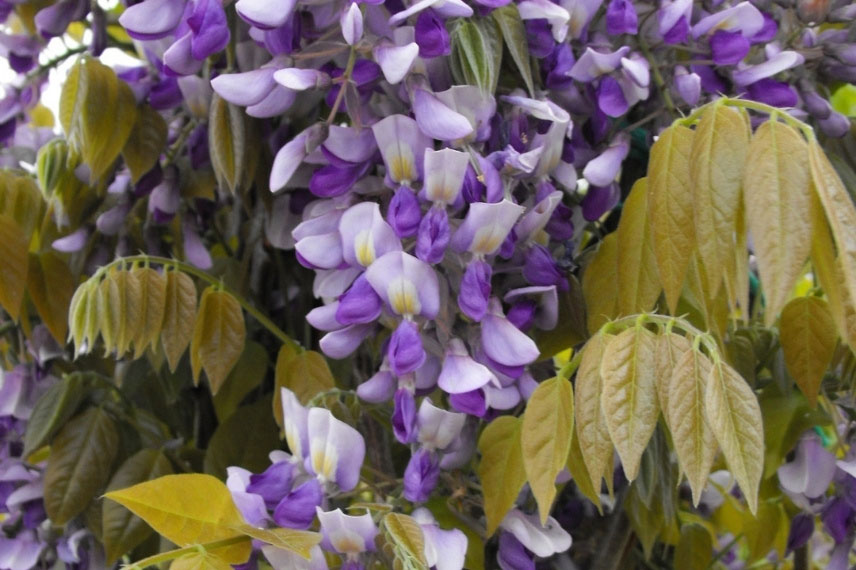
Wisteria (x) venusta ‘Grande Diva Nathalie’
Read also
Choosing your wisteria: buyer's guideChinese Wisteria 'Alba': a springtime purity
The golden-green foliage of this magical Chinese Wisteria Wisteria sinensis ‘Alba’ serves as a backdrop for its luminous clusters of pure white flowers. Both appear at the same time, celebrating the arrival of spring. The Chinese Wisteria is highly prolific: capable of climbing over 9 m and spreading up to 4 m, it quickly produces dense vegetation once established. Its long, green, flexible shoots transform into wood, forming sturdy branches that embrace supports.
Thus, this wisteria forms a solid trunk over the years, which will encircle the support around which it has wound in a counterclockwise direction. Anticipate this phenomenon by guiding it, for example, onto a “temporary” support (like a large wooden stake) that will be replaced by the trunk after a few years. The flowering of this variety deserves attention: the generous clusters consist of pure white papilionaceous flowers punctuated with a pale yellow stripe. They emit a very pleasant floral and honeyed fragrance and hang gracefully for over 50 cm in April and May. They are visited by pollinating insects that particularly appreciate them. All gardeners can fully enjoy this beautiful wisteria: easy to cultivate and thriving in any region, it is truly uncomplicated to care for, tolerating all types of soil, cold, and intense heat!
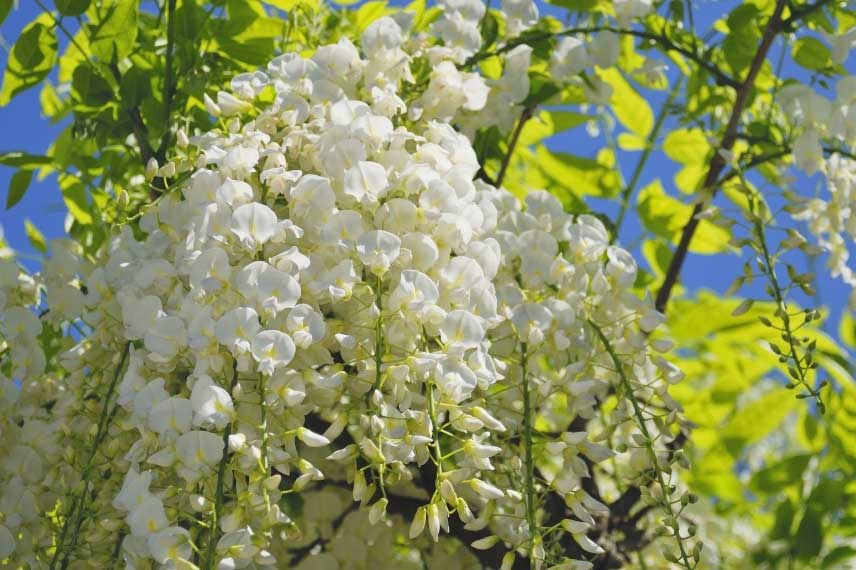
Wisteria sinensis ‘Alba’
Japanese wisteria Macrobotrys 'De Belder': very long clusters
Wisteria floribunda Macrobotrys is the wisteria producing the longest clusters of flowers. The variety ‘De Belder’ is a rare selection, with flowering clusters that can reach up to 1.40 m! Its growth is just as vigorous as that of other Japanese wisterias, introduced to Europe in the 19th century and native to Japanese forests. The long voluble stems extend over 10 m to gradually form sturdy branches. Not demanding regarding soil and climate, the Wisteria floribunda Macrobotrys‘De Belder’ blooms prolifically in May-June in trailing clusters, with hundreds of bicoloured flowers in mauve and violet. The numerous leaves appear before these flowers and bronze in colour, turning to a light green until autumn when the plant will enter a vegetative rest until the following spring. Plant this wisteria alone on a support as its rapid and generous growth would compete with any other plant. And let’s admit it, it is a spectacle in its own right!
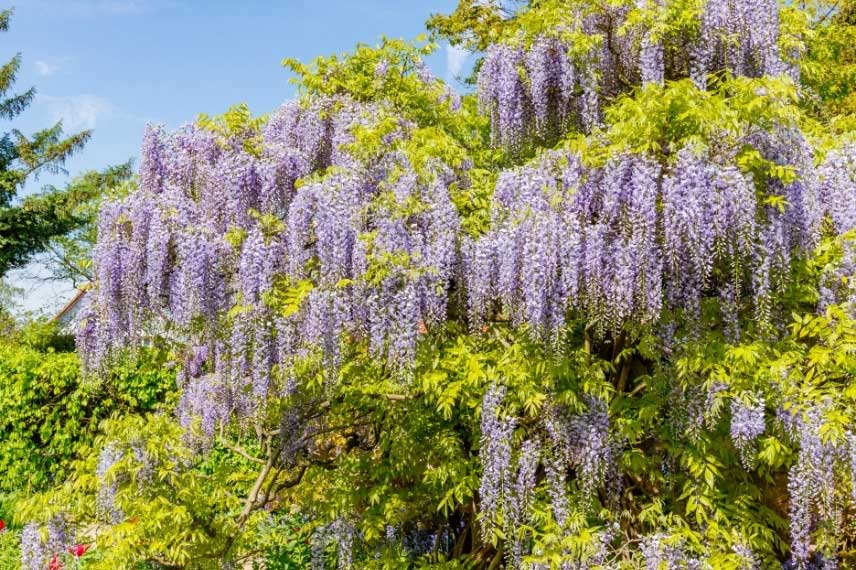
Wisteria floribunda Macrobotrys ‘De Belder’
Wisteria floribunda 'Violacea Plena': a charming beauty
The appeal of this lovely Japanese Wisteria lies in its double flowering, which is quite rare among wisterias. Wisteria floribunda ‘Violacea Plena’, also known as ‘Double Black Dragon’, indeed adorns itself in May and June with charming mauve-violet pompom flowers, forming lush clusters of 30 to 40 cm. Set against the light green deciduous foliage, they create a soft and soothing ensemble, with a very pleasant honey-like fragrance. Planted in full sun or partial shade, it grows quickly and vigorously up to 10 m: care should be taken not to plant other subjects nearby, as it would eventually invade them without hesitation. Hardy, it is also not demanding regarding soil type.

Wisteria floribunda ‘Violacea Plena’
For further reading
- Discover how to grow wisteria in a pot
- Browse our article: How to associate wisteria?
- Subscribe!
- Contents
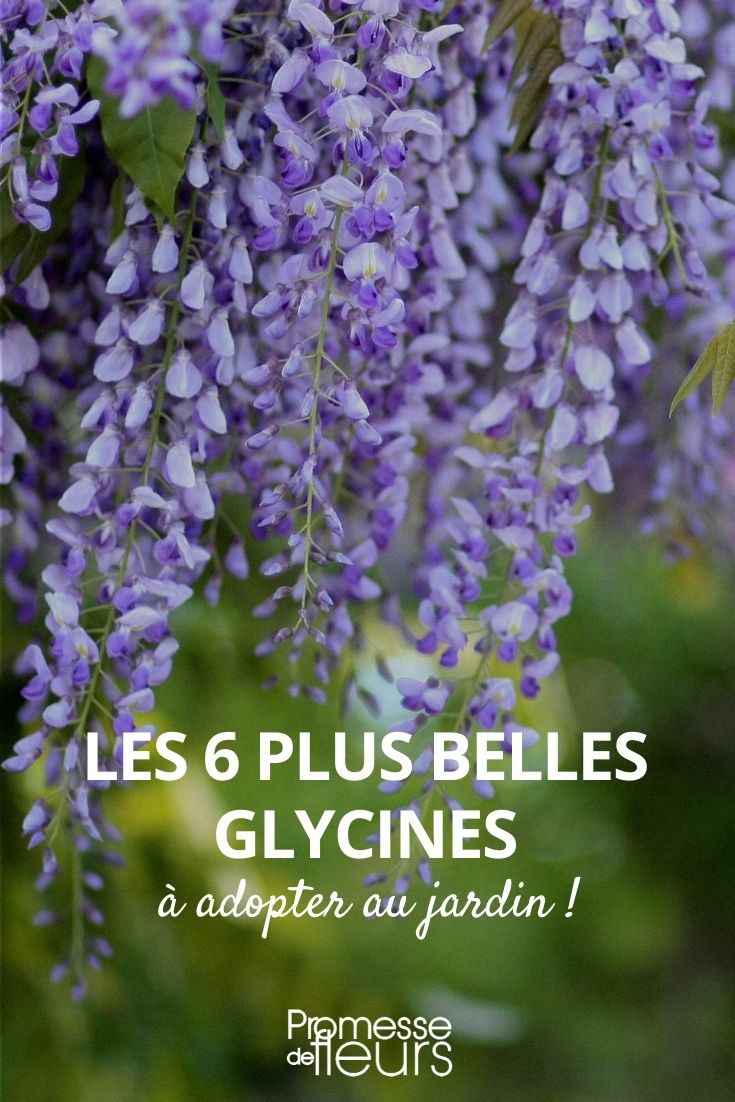































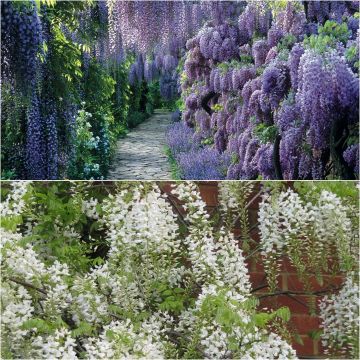
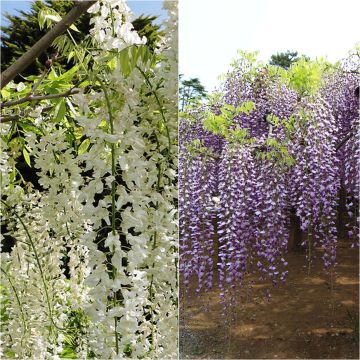



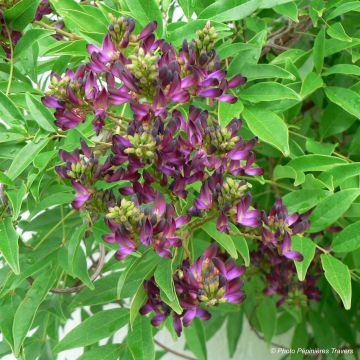
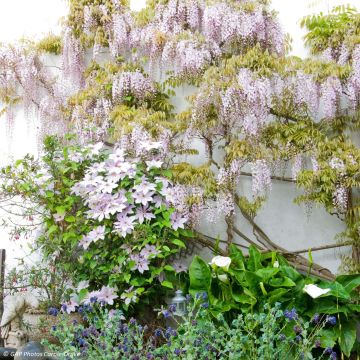
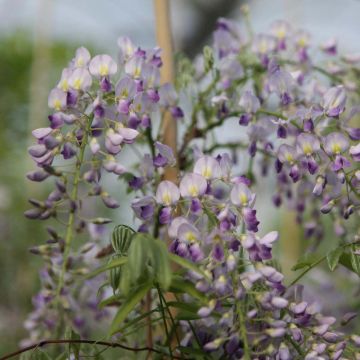
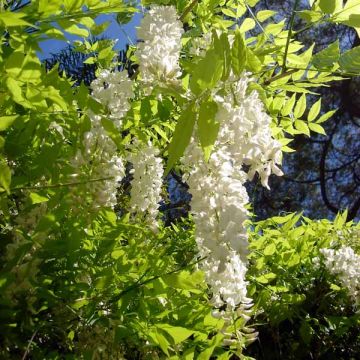
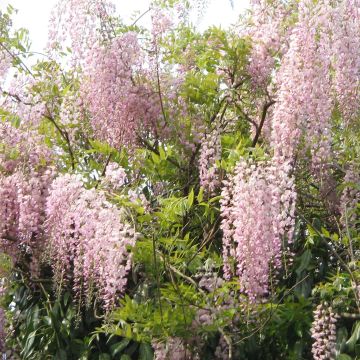
Comments